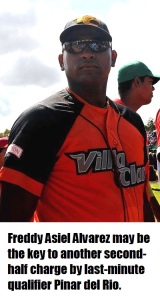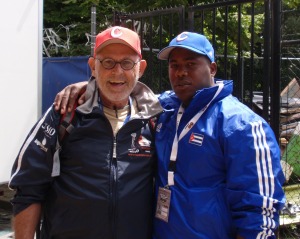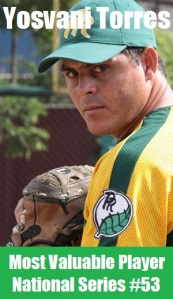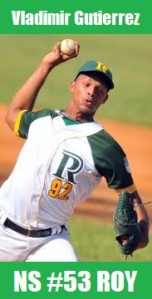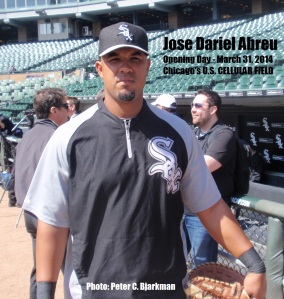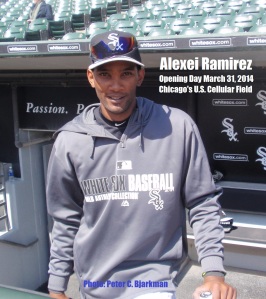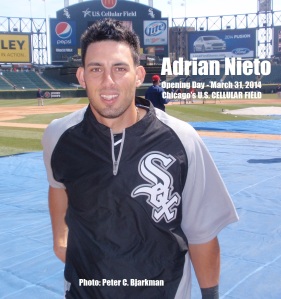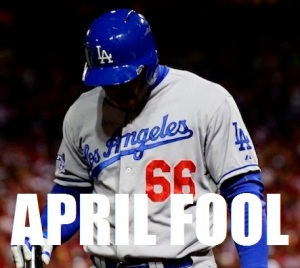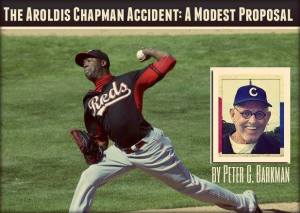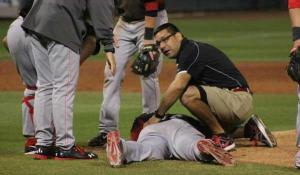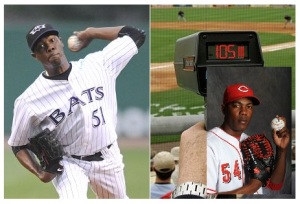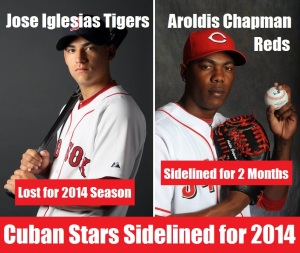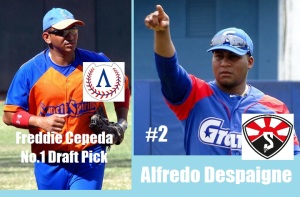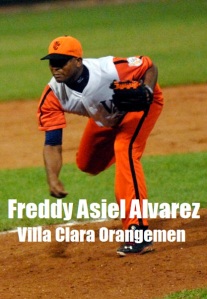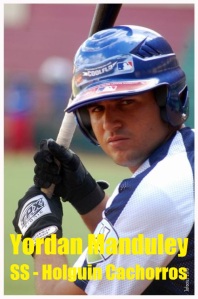Cuban League’s Expanded Player Draft for Season’s Championship Round
For the third straight year of split-season league play, Cuba held its nationally televised player dispersal draft on Christmas night, this time with a new wrinkle. For this year’s National Series #54 edition the mid-year selection of reinforcement players from the eight eliminated teams was expanded from five to seven rounds and thus also from the original 40 to a new total of 56 ballplayers. The novel system represents a controversial departure from Cuba’s long-established traditional structure that found ballplayers performing only for their native provinces and never (before National Series #52 in 2012-13) switching team affiliations in the course of a single championship season. Until recently the Cuban circuit had always prided itself as being a league with no player trades and thus with long-term loyalties forged between clubs, fans, and star athletes. But all that has now changed with approximately 15 percent of the league’s personnel swapping uniforms at the season’s half-way point.
What didn’t change this time around was the heavy preference for pitchers, with only three position players (catchers Yosany Alarcón and Yulexis La Rosa, and infielder Luis Yander La O) among the eight first-round lottery selections. Despite the ongoing tradition of preferential interest in pitching reinforcements, for the first time a hurler (Camagüey ace Norge Luís Ruíz) was the overall top pick (chosen by Holguín). Last winter slugger Freddie Cepeda was the top individual selection (by Artemisa), and in the inaugural December 2012 draft ritual Pinar del Río opted for home run king Alfredo Despaigne. Cepeda ended up once again in Artemisa this time out as a second round pick while his veteran Sancti Spíritus teammates Yunior Mendoza (Matanzas) and Eriel Sánchez (Holguín) were also noteworthy selections.
The draft system finds the eight surviving teams picking in reverse order of the current league standings for the initial round, and then reversing order for round two; the final five rounds this season had the picking order selected by a blind draw before each subsequent cycle. The round-by-round top picks with this “luck-of-the-draw” lottery fell to Artemisa (Round 3), Isla de la Juventud (Round 4), again Isla (Round 5), first place Matanzas (Round 6), and finally Isla yet again (Round 7). Among the league’s eliminated also-rans, Las Tunas headed the pack in providing eleven draftees, followed by Villa Clara with ten.
When assessing the overall selections it might appear that Pinar del Río and Artemisa have now best positioned themselves for a strong second half championship run. Pinar’s defending league champions (already loaded in the hurling department with top starter Yosvani Torres, emerging bullpen stalwart Vladimir Guitiérrez, and veteran righty Vladimir Baños) walked off with Villa Clara ace Freddy Asiel Alvarez (the country’s best arm alongside Norge Luís) plus Villa Clara’s durable right-hander Yosvany Pérez. Artemisa in turn added some much-needed offensive punch to its light-hitting lineup with the added presence of the dependable switch-hitting Cepeda and slugging catcher Yosvani Alarcón. But the league’s seven top challengers will have a tough time overhauling Victor Mesa’s solid Matanzas lineup now reinforced with solid infield offensive and defensive strength in the form of third sacker Luis Yander La O (a rising star during the recent Central American Games in Vera Cruz) plus veteran first baseman Yunier Mendoza (this year’s surprise first-half batting leader).
Reinforcement Player Draft Selection Summary
Eighth-Place Team
Holguín Cachorros (Record 23-22, .511, 8.0 GB)
Manager: Irochis Bartutis Pérez
Lottery First Round: Norge Luis Ruiz (Camagüey) RHP
Round 2: Edilse Silva (Santiago de Cuba) Outfielder
Round 3: Yordan Batista Gilbert (Las Tunas) Infielder (seventh pick)
Round 4: Eriel Sánchez (Sancti Spíritus) Catcher (fourth pick)
Round 5: Frank Navarro Noa (Guantánamo) RHP (fifth pick)
Round 6: Reutilio Hurtado (Santiago de Cuba) Outfielder (fifth pick)
Round 7: Lander Moreira Rodríguez (Guantánamo) LHP (fourth pick)
Seventh-Place Team
Pinar del Rio Vegueros (Record: 24-21, .533, 7.0 GB)
Manager: Alfonso Urquiola
Lottery First Round: Freddy Asiel Alvarez (Villa Clara) RHP
Round 2: Yordanis Linares (Villa Clara) Outfielder
Round 3: Dennis Laza (Mayabeque) Outfielder (fourth pick)
Round 4: Andrés Quiala Herrera (Las Tunas) Outfielder (seventh pick)
Round 5: Yordan Alvarez (Las Tunas) Infielder (fourth pick)
Round 6: Yosvany Pérez (Villa Clara) RHP (sixth pick)
Round 7: Andy Sarduy (Villa Clara) Infielder (third pick)
Sixth-Place Team
Ciego de Avila Tigres (Record 24-21, .533, 7.0 GB)
Manager: Roger Machado
Lottery First Round: Ismel Jiménez (Sancti Spíritus) RHP
Round 2: Giorbis Duvergel (Guantánamo) Outfielder
Round 3: Yeniet Pérez (Villa Clara) Infielder (third pick)
Round 4: Leorisbel Sánchez Hernández (Cienfuegos) LHP (fifth pick)
Round 5: Ariel Borrero (Villa Clara) First Baseman (eighth pick)
Round 6: Alaín Sánchez (Villa Clara) RHP (third pick)
Round 7: Orlando Lavandera (Mayabeque) Outfielder (seventh pick)
Fifth-Place Team
Industriales Leones (Record: 25-20, .556, 6.0 GB)
Manager: Lázaro Vargas
Lottery First Round: Alberto Bicet (Santiago de Cuba) RHP
Round 2: Dany Betancourt (Santiago de Cuba) RHP
Round 3: Vicyohandry Odelín (Camagüey) RHP (second pick)
Round 4: Ronny Valdés (Villa Clara) RHP (third pick)
Round 5: Félix Carbonell Guantánamo) Catcher (seventh pick)
Round 6: Dairon Blanco (Camagüey) Outfielder (fourth pick)
Round 7: Giorgis Cuevas (Santiago de Cuba) RHP (second pick)
Fourth-Place Team
Artemisa Cazadores (Record: 25-20, .556, 6.0 GB)
Manager: Dani Valdespino
Lottery First Round: Yosvani Alarcón (Las Tunas) Catcher
Round 2: Frederich Cepeda (Sancti Spíritus) Outfielder
Round 3: Danel Castro (Las Tunas) Infielder (first pick)
Round 4: Angel Peña (Sancti Spíritus) RHP (sixth pick)
Round 5: Yosbel Alarcón) (Las Tunas) RHP (sixth pick)
Round 6: Robersis Ramos (Sancti Spíritus) Outfielder (seventh pick)
Round 7: Michael González (Mayabeque) Infielder (eighth pick and final draft selection)
Third-Place Team
Isla de la Juventud Piratas (Record: 27-18, .600, 4.0 GB)
Manager: José Luis Rodríguez
Lottery First Round: Yoelkis Cruz (Las Tunas) RHP
Round 2: Darien Núñez (Las Tunas) LHP
Round 3: Jorge Luía Barcelán (Mayabeque) Infielder (sixth pick)
Round 4: Ulfrido García Andújar (Santiago de Cuba) LHP (first pick)
Round 5: Julio Pablo Martínez (Guantánamo) Outfielder (first pick)
Round 6: Yusniel Ibáñez (Cienfuegos) Outfielder (eighth pick)
Round 7: Javier Vázquez (Sancti Spíritus) LHP (first pick)
Second-Place Team
Granma Alazanes (Record: 29-16, .644, 2.0 GB)
Lottery First Round: Yulexis La Rosa (Villa Clara) Catcher
Round 2: Juan Viera (Las Tunas) RHP
Round 3: Dariel Góngora de la Torre (Camagüey) LHP (eighth pick)
Round 4: Yordanis Alarcón (Las Tunas) Infielder (second pick)
Round 5: Yudiel Rodríguez León (Las Tunas) LHP (second pick)
Round 6: Yankiel Mauri Gutiérrez (Sancti Spíritus) RHP (second pick)
Round 7: Yoennis Turcas Maure (Guantánamo) RHP (sixth pick)
First-Place Team
Matanzas Cocodrillos (Record: 31-14, .689, – GB)
Manager: Victor Mesa
Lottery First Round: Luis Yander La O (Santiago de Cuba) Infielder
Round 2: Alexei Bell (Santiago de Cuba) Outfielder
Round 3: Pedro Agüero Castillo (Guantánamo) RHP (fifth pick)
Round 4: Yasmany Hernández (Villa Clara) RHP (eighth pick)
Round 5: Yadier Hechavarría (Las Tunas) RHP (second pick)
Round 6: Luis Borroto (Villa Clara) RHP (first pick)
Round 7: Yunier Mendoza (Sancti Spíritus) First Baseman (fifth pick)
Season play will continue after this weekend’s All-Star Game festivities in Granma Province with the 45-game championship round set to start on Sunday, January 4. The eight-team circuit will continue through March 19, with a three-week hiatus during the final week of January and the first two weeks of February to accommodate Caribbean Series action in San Juan, Puerto Rico. The top four league finishers will enter the best-of-seven semifinal series during the final weekend of March, with the league championship finals on tap for early April.

